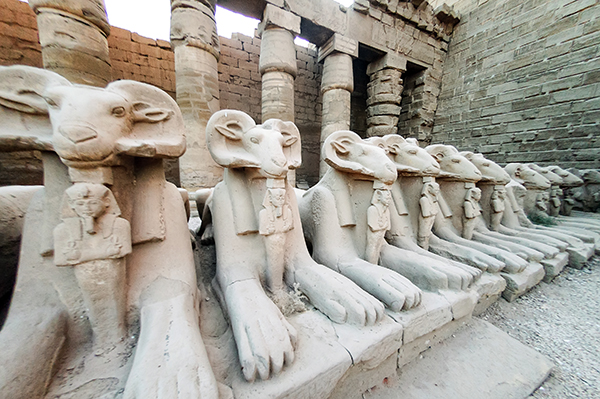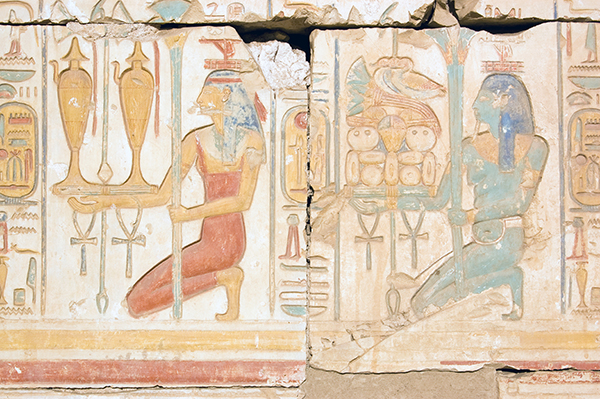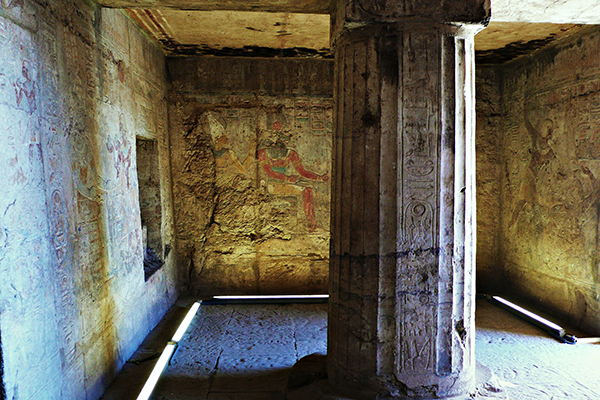

Karnak Temple, Luxor

Hatshepsut Temple, Deir el-Bahari, near Luxor

Ramses Temple at Abydos

Muhammad Ali Mosque, Cairo



Karnak Temple, Luxor

Hatshepsut Temple, Deir el-Bahari, near Luxor

Ramses Temple at Abydos

Muhammad Ali Mosque, Cairo

Mandulis (Kalabsha) Temple from Lake Nasser, near Aswan, Egypt

Mandulis (Kalabsha) Temple, near Aswan, Egypt
Not far off the well-beaten-path of ancient temples in Egypt is the Mandulis Temple, also known as the Kalabsha Temple for the island on which it originally stood. This temple is one of several that was disassembled and moved to higher ground in the 1960s, ahead of the creation of the massive Lake Nasser reservoir, which would have submerged them. The reconstructed temple now stands on New Kalabsha Island near the western shore of Lake Nasser, just south of the Aswan High Dam.

Mandulis (Kalabsha) Temple, near Aswan, Egypt
Mandulis is a late-Greek-early-Roman-era temple, built around 30 BCE. The temple is Nubian, not Egyptian, but Nubian assimilation into Egyptian culture was pretty much complete by this late date and the temple’s design is typically Egyptian. Mandulis was the Greco-Roman version of the Nubian sun god Merwel.
Lake Nasser cruises include Mandulis in their touring itineraries. Our Splendors of Ancient Egypt program includes a Lake Nasser cruise. If you’re not taking a Lake Nasser cruise, we can get you there by other means, just ask.

Karnak Temple is one of the main attractions in our mystery city. Also nearby are the Valley of the Kings, the Valley of the Queens and the Temple of Hatshepsut. These are all must-see sites for visitors to Egypt. The city, about 300 miles south of Cairo in the Nile Valley, was the capital of ancient Egypt during its most prosperous and powerful time and the cult center of the god Amun. Even after its prime, the city was legendary throughout the Mediterranean region and beyond for its wealth and beauty. The ancient Greeks and Romans called it Thebes. To the ancient Egyptians, it was Waset. Today it is known by a different name.
Can you name that city?
See below for answers.






This is the so-called Avenue of Rams or Ram-headed sphinxes leading to the 1st pylon (monumental gateway) of the sprawling Karnak Temple in Luxor. Like the famous sphinx at Giza in the north of the country, these sphinxes have the body of a lion. The figures between their legs represent Ramesses II, one of the country’s most influential ancient kings.
Can you name that country?
See below for answers.

the Temple of Seti I, aka The Great Temple of Abydos
Abydos is among the most important archaeological sites in Egypt, with remains of structures and tombs from predynastic times into Ptolomaic times, 3,000 years of Egyptian history.
Abydos began as a royal necropolis of the pre-dynastic capital Thinis and cult center of the regional god Khentiamentiu. Royal burial was well-established here by the time Egypt was unified under Narmer (or Menes, possibly the same person), founder of the 1st dynasty around 3,100 BCE. The kings of the 1st dynasty and two from the 2nd dynasty were buried here before the capital was moved north to Memphis.
The local god Khentiamentiu eventually merged with the god Osiris, king of the dead. Osiris was believed to be buried at Abydos, and the religious significance of Abydos as cult center of Osiris continued after the capital moved. For thousands of years, an annual procession reenacted stories from the life and death of Osiris and drew pilgrims from all over Egypt. A Great temple of Osiris was built, rebuilt, expanded and embellished by successive pharaohs across three millennia.
Egyptians with means sought to be buried near Osiris. Short of that, a personal burial monument (cenotaph or stelae) was placed near the tomb of the god. Thousands of these cenotaphs have been found. A number of pharaohs built mortuary temples at Abydos, although entombed elsewhere. The Temple of Seti I, is one such temple, and the best preserved monument at Abydos today.

the Temple of Seti I, aka The Great Temple of Abydos

wall painting in the Rameses II Temple, Abydos
Because nearby accommodations are limited, we usually offer Abydos as a day trip from Luxor, about 3 hours drive one-way. An Abydos visit from Luxor is often combined with a stop at Denderah, which is about midway between.

temple of Seti I at Abydos

tomb of Thutmose IV, Valley of the Kings

Giza

Muhammad Ali Mosque, Cairo

“recumbent” Ramses II at Memphis
Way down in the far, far south of Egypt stand the temples of Abu Simbel, my pick for the most dramatic monument in Egypt. That’s saying a lot, because, as you know, Egypt is full of dramatic monuments. I think the impression of Abu Simbel is amplified by its lonely, barren location. It’s really in the middle of nowhere, raised in the 13th century BCE by Ramesses the Great to impress visitors on his southern frontier. Traders and ambassadors knew they entered a rich and powerful nation, potential invaders knew what they were up against if they chose to push forward, like a border sign reading, “Welcome to Egypt, Don’t get on our bad side.”
The Great Temple is dedicated to Ramesses, as well as the three main gods of the time, Amun, Ra-Horakhty and Ptah, and features four 65-ft. colossal statues of the seated pharaoh on the facade. Inside the temple, two hypostyle halls lead to the spooky inner sanctuary with seated statues of the pharaoh and gods. The halls through the temple are covered in bas-relief and painted scenes of Ramesses doing kingly things, like crushing his enemies and consorting with the gods, and colossal statues of the pharaoh line the walls on either side.
The Small Temple is dedicated to the goddess Hathor and Ramesses’ queen, Nefertari.
It’s less grand but more elegant, with six 33-foot standing statues on the facade – 2 of the king and 1 of the queen on either side of the portal. Never before or after was a queen shown the same size as the king in Egyptian art.
The setting of the temples really enhances their impact. Blue water, blue sky, brown earth is pretty much all you see for hundreds of miles – forlorn, forgotten, untouched and then suddenly the temples are there like a smack in the face, in a good way.
In the 1960s, the temples at Abu Simbel were moved from their original location, which was due to be flooded after the construction of the Aswan High Dam down river.
The temples were cut into 20-ton blocks and moved about 200 feet to higher ground. The temples were originally carved into the face of a mountain, so part of the move included building an artificial mountain. The hollow mountain is open to visitors and contains an exhibit about the temples’ rescue.
Abu Simbel is reached from Aswan by about an hour flight or a 3-4 hour overland convoy of motor coaches and mini vans. It’s also possible to cruise from Aswan across Lake Nasser to Abu Simbel.
 The most famous remains of ancient Thebes is the rambling Karnak Temple. Within the temple, the Hypostyle Hall is a forest of massive columns, some 70-feet tall. The columns are covered in carvings detailing adventures of ancient kings. The columns were originally also covered in brilliant color, traces of which still remain in some areas.
The most famous remains of ancient Thebes is the rambling Karnak Temple. Within the temple, the Hypostyle Hall is a forest of massive columns, some 70-feet tall. The columns are covered in carvings detailing adventures of ancient kings. The columns were originally also covered in brilliant color, traces of which still remain in some areas.
Can you name that country?
See below for answers.

Abu Simbel

Alexandria

the Red Pyramid of Dahshur

Temple of Horus at Edfu

Karnak Temple, Luxor